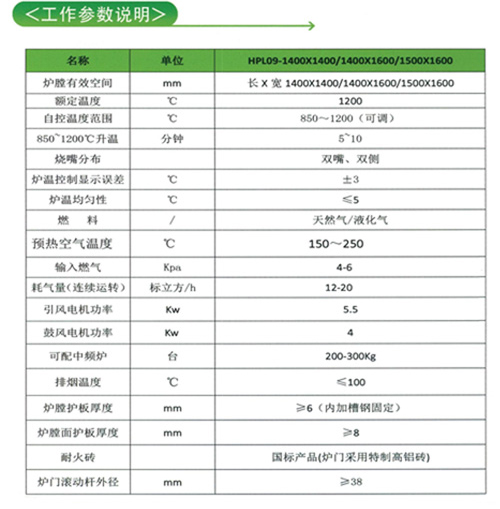Main structural features:
1. Furnace body
The furnace body is composed of a furnace shell and a furnace lining.
The furnace shell is made of welded steel to form a frame structure of the furnace body skeleton. Steel plates with a thickness of ≥ 6mm are welded to the inner surface of the furnace body skeleton, and the steel plates are fixed with channel steel. A 100mm thick high aluminum fiber blanket is added around the furnace body.
On the side wall of the furnace shell, corresponding burner seat holes are arranged at the position of the burner, and pressure adjustment pipeline seat holes and temperature measurement thermocouple seat holes are opened behind the furnace. The connection between the burner and the furnace body is filled with external refractory cement to ensure that no fire occurs. The top and sides of the furnace door frame in contact with the furnace door on the furnace shell are made of high-temperature resistant steel plates. To prevent thermal deformation, they are connected by block joints.
The furnace lining adopts a combination structure of high alumina refractory bricks according to national standards and fiber prefabricated modules with a bulk density of 220kg/m3. This structure has the lowest thermal conductivity, which is beneficial for the insulation of the furnace lining; High alumina refractory bricks are used as the refractory layer in the high-temperature section of the furnace lining. The high alumina refractory bricks are perpendicular to the heating surface and have low shrinkage (less than 4%) at high temperatures. They have good resistance to high temperatures and airflow erosion. Therefore, this method is widely used in similar furnace types and has achieved good results. The furnace lining has good air tightness, is easy to maintain, and has a long service life. The furnace top is poured with high-temperature refractory cement.
2. Furnace door
The main material of the furnace door is made of steel plates and welded steel sections, and the surrounding frame plates are made of heat-resistant cast steel, which not only ensures the overall rigidity and strength of the furnace door, but also makes it lighter and reduces its weight. The fiber lining construction adopts the hanging and riveting method, which can effectively ensure the firmness of the fiber due to frequent opening and closing of the furnace door, and increase the service life of the furnace door. The furnace door adopts a thickened ceramic fiber blanket, and the steel plate on the furnace face is thickened to 8m.
The furnace door lifting adopts electric lifting method. In order to prevent damage to the sealing strip of the furnace door edge, the furnace door moves up and down. When the furnace door is lifted, it is separated from the furnace body by about 80mm, so that the steel structure of the furnace door does not deform and the sealing is reliable when it is opened at high temperature for a long time. The lifting speed of the furnace door is 6m/min.
The lifting and lowering of the furnace door has a protective function. When the furnace temperature drops below 800 ℃ during cold furnace heating, the automatic protection of the furnace door cannot be closed.
3. Electrical control system
The equipment adopts a Siemens brand PLC for centralized control, using imported electrical components such as Japanese ORMON travel switch and Schneider switch electrical. The function settings have three control states: adjustment, manual, and automatic, which can be manually switched. The PLC can set the furnace temperature, burner temperature, burner switching time, etc. according to user requirements, and can display them intuitively. After reaching the set temperature, it can automatically switch between high and low fire to ensure constant temperature of the furnace. The control box should be equipped with a LCD display, which can intuitively display the furnace temperature, burner temperature, and exhaust temperature on site.
Each switch button is clearly labeled, and the process time is adjusted using Omron external time relays.
Set up photoelectric protection switches, safety switches for lifting doors, emergency stop buttons, and provide comprehensive mechanical protection for equipment and operators. Set up three color working warning lights, with green indicating working status, yellow indicating standby, and red indicating fault alarm. The main electrical cabinet is connected to the machine body, and a starter box is attached in front of the machine for easy operation.


